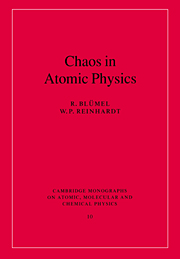Book contents
- Frontmatter
- Contents
- Preface
- 1 Introduction
- 2 Chaos: tools and concepts
- 3 Chaos in classical mechanics
- 4 Chaos in quantum mechanics
- 5 The kicked rotor: paradigm of chaos
- 6 Microwave-driven surface state electrons
- 7 The hydrogen atom in a strong microwave field
- 8 The kicked hydrogen atom
- 9 Chaotic scattering with CsI molecules
- 10 The helium atom
- 11 Chaos in atomic physics: state of the art and research directions
- References
- Index
11 - Chaos in atomic physics: state of the art and research directions
Published online by Cambridge University Press: 14 September 2009
- Frontmatter
- Contents
- Preface
- 1 Introduction
- 2 Chaos: tools and concepts
- 3 Chaos in classical mechanics
- 4 Chaos in quantum mechanics
- 5 The kicked rotor: paradigm of chaos
- 6 Microwave-driven surface state electrons
- 7 The hydrogen atom in a strong microwave field
- 8 The kicked hydrogen atom
- 9 Chaotic scattering with CsI molecules
- 10 The helium atom
- 11 Chaos in atomic physics: state of the art and research directions
- References
- Index
Summary
The purpose of this chapter is to discuss briefly, and as far as we are aware of it, the present status of research on chaos in atomic physics including trends and promising research directions. Given the enormous and rapidly growing volume of literature published every year, we cannot provide within the scope of this chapter a complete overview of existing published results. The best we can do is to select – in our opinion – representative results that indicate the status and trends in the field of chaos in atomic physics.
In Section 11.1 we discuss recent advances in quantum chaology, i.e. the semiclassical basis for the analysis of atomic and molecular spectra in the classically chaotic regime. In Section 11.2 we discuss some recent results in type II quantum chaos within the framework of the dynamic Born-Oppenheimer approximation. Recent experimental and theoretical results of the hydrogen atom in strong microwave and magnetic fields are presented in Sections 11.3 and 11.4, respectively. We conclude this chapter with a brief review of the current status of research on chaos in the helium atom.
Quantum chaology
Quantized chaos, or quantum chaology (see Section 4.1), is about understanding the quantum spectra and wave functions of classically chaotic systems. The semiclassical method is one of the sharpest tools of quantum chaology. As discussed in Section 4.1.3 the central problem of computing the semiclassical spectrum of a classically chaotic system was solved by Gutzwiller more than 20 years ago.
- Type
- Chapter
- Information
- Chaos in Atomic Physics , pp. 284 - 295Publisher: Cambridge University PressPrint publication year: 1997



